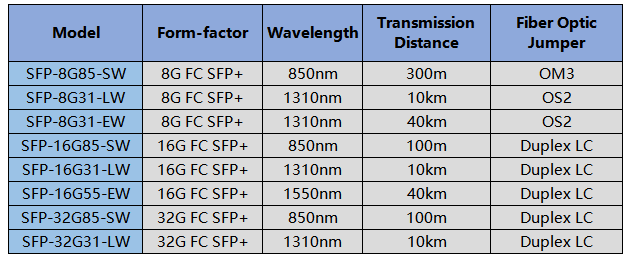

Sort by :Price: Low to High
Categories
{{cate.name}}
view {{page_size}}
What is FC (Fibre Channel) SFP+ module?
Fibre Channel (FC) is a high-speed network interconnection technology (usually running at 2Gbps, 4Gbps, 8Gbps, 16Gbps and 32Gbps), which is mainly used to connect computer storage devices. In the past, Fibre Channel was mostly used for supercomputers, but now it is also becoming a common connection type in an enterprise’s Storage Area Network (SAN). Despite being called fibre channel, its signals can also run over twisted-pair cable.
The 8G FC SFP+ optical module is mainly used in FC (Fibre Channel) network. Fibre channel technology is a network storage switching technology, which can provide long-distance and high bandwidth, and can realize the transmission of large data files among storage, server and client nodes. The 8G SFP+ optical module can support 100m/10km/40km data transmission distance. It is not only affordable, but also backward compatible, and can operate at 4.25Gbps and 2.125Gbps.
The Fibre Channel “16G FC” standard completed in 2009 by the INCITS T11.2 Task Group defines the high-speed optical transceivers that will address the I/O bottlenecks that arise with increased channel utilization. These optical transceivers are compliant with small form pluggable (SFP) industry agreements INF-8074i (SFP) and SFF-8431 (SFP+) for mechanical and low-speed electrical specifications. They also are backwards compatible, which provides a simple migration path to better SAN performance.

The 16G FC SFP+ modules are divided into three types: 100m/10km/40km. The 16G FC SFP SW with a transmission distance of 100m over OM3 multimode jumper and has a wavelength of 850nm, supports a transmission rate of up to 14.025Gbps, dual LC interface, supports DDM, the working temperature range is 0 ° C ~ 70 ° C.
The other two types are 16G FC SFP LW and 16G EW. Their transmission distances are 10km and 40km respectively, and their wavelengths are 1310nm and 1550nm respectively. They support transmission rates up to 14.025gbps, dual LC interfaces, support DDM, and the operating temperature range is 0 ° C ~ 70 ° C.
The 32G Fibre Channel SFP+ can more efficiently support the network upgrade of SAN users and help enterprises upgrade storage area networks with higher capacity. The 32G FC SFP28 module is compatible with 8G/16G fibre channel. There are two main types of 32G FC SFP optical modules:
32G FC SFP SW adopts hot-pluggable SFP28 package, with wavelength of 850nm, dual LC interface, maximum speed of 28.05Gbps and working temperature range of 0 ° C ~ 70 ° C. DS SFP FC32G SW is compatible with 8G/16G fiber channel standard, and the transmission distance can be up to 70m by using OM3 multimode fiber; With OM4 multimode fiber, the transmission distance can be up to 100m.
32G FC SFP LW adopts hot-pluggable SFP28 package, with wavelength of 1310nm, dual LC interface, maximum speed of 28.05Gbps and working temperature range of 0 ° C ~ 70 ° C. It is compatible with 8G/16G fibre channel standard, and the transmission distance can be up to 10km by using OS2 single-mode fiber.
For large enterprise data centers or SANs, the improvement in watts per gigabit per second should not be overlooked. Migrating from 8G or 16G infrastructure to 32G FC can have a significant impact on electricity costs while helping to meet corporate “Green” targets.
Availability: Data storage for core services cannot be interrupted, and Fibre Channel networks can ensure that data is accessed in real-time.
Performance: Fibre channel transceiver can provide better performance for core service.
Expansibility: Fibre channel network can ensure that when the business expands and storage capacity increases, there is a corresponding network foundation that can support such a business system.
Security: Fibre channel is a natural security system. A hacker can attack the ID network inside the data center and attack the servers, but he cannot attack your storage network because the SAN(Storage Area Network) is naturally isolated from the outside world. SAN can protect data and reduce the risk of data leakage

Fiber Mall's fibre channel transceiver series includes 8G, 16G, 32G optical modules. Compatible with BROCADE, HPE, IBM, Cisco, Juniper Networks, H3C, Huawei and other brands of Fibre Channel switches.